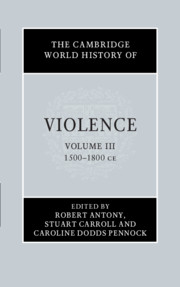Book contents
- The Cambridge World History of Violence
- The Cambridge World History of Violence
- The Cambridge World History of Violence
- Copyright page
- Contents
- Figures
- Maps
- Contributors to Volume iii
- Introduction to Volume iii
- Part I Empire, Race and Ethnicity
- Part II Cultures of War and Violence
- Part III Intimate and Gendered Violence
- 11 Legal Understandings of Sexual and Domestic Violence in Late Imperial China
- 12 Samurai, Masculinity and Violence in Japan
- 13 Gender and Violence in Early America
- 14 Sexual and Family Violence in Europe
- 15 Men Fighting Men: Europe from a Global Perspective
- 16 Suicide in the Early Modern World
- Part IV The State, Punishment and Justice
- Part V Popular Protest and Resistance
- Part VI Religious and Sacred Violence
- Part VII Representations and Constructions of Violence
- Index
- References
16 - Suicide in the Early Modern World
from Part III - Intimate and Gendered Violence
Published online by Cambridge University Press: 13 March 2020
- The Cambridge World History of Violence
- The Cambridge World History of Violence
- The Cambridge World History of Violence
- Copyright page
- Contents
- Figures
- Maps
- Contributors to Volume iii
- Introduction to Volume iii
- Part I Empire, Race and Ethnicity
- Part II Cultures of War and Violence
- Part III Intimate and Gendered Violence
- 11 Legal Understandings of Sexual and Domestic Violence in Late Imperial China
- 12 Samurai, Masculinity and Violence in Japan
- 13 Gender and Violence in Early America
- 14 Sexual and Family Violence in Europe
- 15 Men Fighting Men: Europe from a Global Perspective
- 16 Suicide in the Early Modern World
- Part IV The State, Punishment and Justice
- Part V Popular Protest and Resistance
- Part VI Religious and Sacred Violence
- Part VII Representations and Constructions of Violence
- Index
- References
Summary
Suicide is a neologism. First conceived in 1643 by Baconian polymath Sir Thomas Browne, it gradually entered enlightened parlance, universalised by Hume’s On Suicide. Previously, richly descriptive and differentiated depictions of the paradox of self-killing permeated the globe. Current research suggests a stronger fixation with self-killing in the West. Condemned by medieval theologians as the sin of despair, alternate tropes appeared during the Renaissance as humanists reintroduced classical models of toleration. Painters elevated Lucretia to the icon of Republican resistance. By the seventeenth century enlightened rationalism had emboldened John Donne to compare Christ’s passion to suicide. Nevertheless, popular culture and the authorities continued to punish the crime of self-murder harshly. Current research allows comparisons with Asia. In Japan, acceptance of seppuku and shinjū contrasted with condemnation for self-sacrifices by Christian converts. In India, Western observers alternately wondered naively at widow burnings (sati) or questioned their consensual nature. In Qing China, a cult of pious widows who killed themselves to avoid forced remarriage gained such popularity that the emperor introduced laws to moderate the proliferation of memorials. Ultimately, the interpretation of self-killing reveals much more about cultural values than it does about the state of mind of individuals performing the violent act.
- Type
- Chapter
- Information
- The Cambridge World History of Violence , pp. 311 - 328Publisher: Cambridge University PressPrint publication year: 2020



